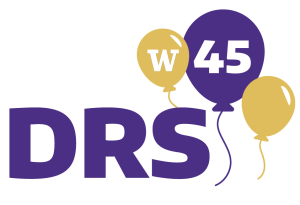DRS History
45th Anniversary of Disability Resources for Students (DRS)
Celebrating 45 years of increasing access and equity at the University of Washington (UW)!
Donate to DRS
Historical Background
Although the University of Washington was founded in 1861, students with disabilities were not entitled to programs or services to support their educational access until the federal implementation of Section 504 in 1977. Section 504 of the Rehabilitation Act of 1973 was the first civil rights protection in the United States to prohibit discrimination against individuals with disabilities in programs and activities that receive federal funding.
The federal guidelines stated that institutions receiving federal financial assistance needed to have surveyed both physical structures and procedural policies for accessibility by mid-1978. A specially appointed committee at the UW completed this assessment. One of their recommendations was to establish an office within Student Affairs to coordinate direct services to disabled students. DRS, called Handicapped Student Services (HSS) at the time, began operating in October of 1978, and changed it’s name to Disability Student Services (DSS) in the 1979.
TIMELINE
- 1977: The provision of Section 504 of the Rehabilitation Act of 1973 was implemented on a national scale.
The UW formed the Handicapped Self-Evaluation Advisory Committee to help the University comply with Section 504, including proposing physical modifications to the built environment (i.e. curb cuts, ramps, etc.) and the establishment of an office within Student Affairs (now Student Life) to coordinate direct disability services. - 1978: The UW Handicapped Student Service (HSS) office opened in October to provide formal accommodations to students with disabilities.
In academic year 1978-79 HSS served 0.7% of the total student population. - 1979: HSS changed its name to Disabled Student Services (DSS).
In academic year 1979-80 DSS served 0.7% of the total student population. - 1980: In academic year 1980-81 DSS served 0.8% of the total student population.
- 1989: UW Bothell was founded and created a DSS office.
- 1981: In academic year 1981-82 DSS served 1.1% of the total student population.
- 1982: UW Disabled Student Services reported in a statistical report:
“With the advent of Section 504, better identification of disabled persons at the elementary and secondary levels, establishment of service programs such as the DSS at the postsecondary level, and the general increase in rehabilitative services coupled with the independent living movement in over the last ten years, a steadily growing number of disabled persons attending college and universities is to be expected … We estimate that as much as 3-5% of the UW student population may be eligible for DSS services within the next ten to fifteen years.” - 1983: WA State Executive Order 98-13: Participation by Disabled Citizens.
- 1990: UW Tacoma was founded and created a DSS office.
- 2004: DSS changed its name to Disability Resources for Students (DRS).
- 2012: DRS moves from Schmitz Hall to Mary Gates Hall (MGH).
Current state of DRS (2024)
The Disability Resources for Students (DRS) office at the University of Washington (UW) has seen transformative growth and shifts since its inception in 1978. DRS has over 7,000 students registered with the office at all three of our campuses (Bothell, Seattle, and Tacoma). This means DRS is currently serving 10% of the undergraduate students and 9% of graduate/professional students. DRS is also serving over 5,000 instructors’ courses and curriculum.
The DRS staff is made up of about 20 professional staff and around 100 student and hourly staff supporting access on all three campuses.
DRS is thankful for all our campus partners and supporters as we all serve students with disabilities! We also acknowledge the work that still needs to be done to make these campuses accessible to all.

